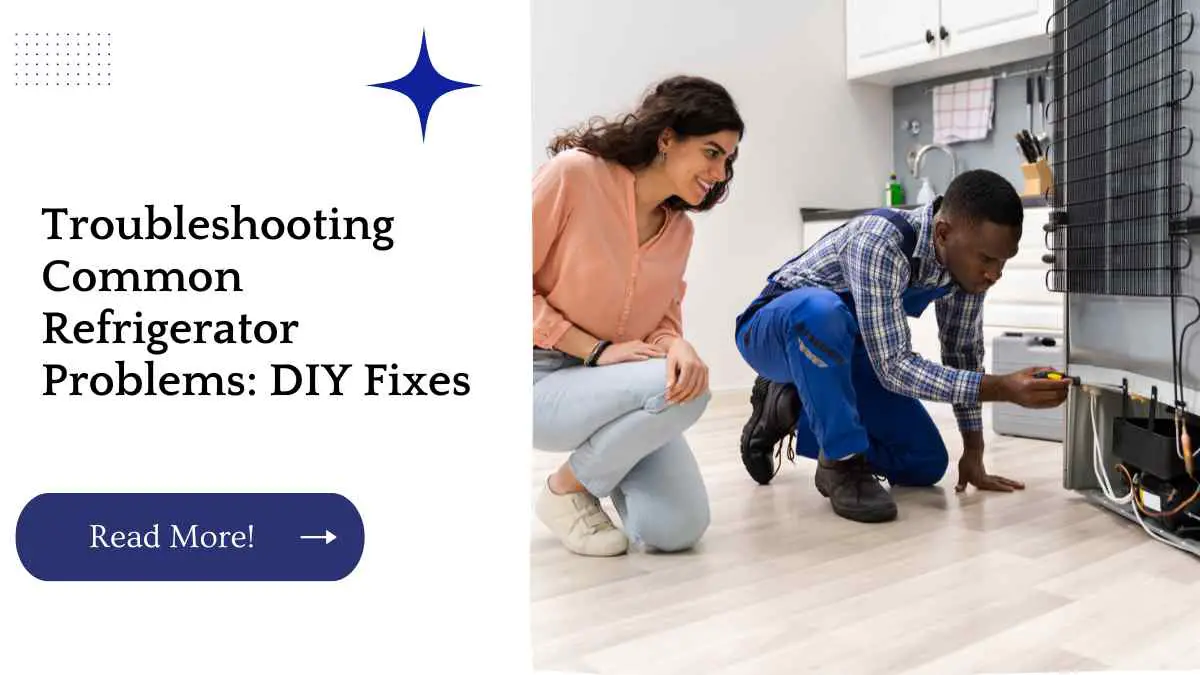Refrigerators are one of the most important household appliances, responsible for keeping our food fresh and safe to eat. However, like any other appliance, refrigerators can develop problems over time that need to be addressed. Some of these problems can be fixed easily without calling in a professional.
In this article, we will discuss common refrigerator problems and provide DIY fixes to help you troubleshoot and resolve them.
| Takeaways |
|---|
| A refrigerator that doesn’t work at all may have issues with the electrical outlet or power cord. |
| Sometimes, refrigerators produce a lot of condensation or water, which is often due to a blockage in the drain line. |
| Excessive noise from your refrigerator may be due to leveled feet, which can be easily fixed by adjusting. |
| A fridge with a constantly cycling motor may be due to a dirty condenser coil or faulty thermostat. |
| If the fridge door does not close properly or seal tightly, it may cause frost buildup due to the warm air entering. |
| Food freezing in the fridge is often due to a faulty temperature control or thermostat. |
Refrigerator is not cooling
If your refrigerator is not cooling properly, there are several possible causes. Here are some troubleshooting steps you can take:
Installing a dishwasher might seem like a daunting task, but it can be completed with ease using the right steps. Our DIY guide for dishwasher installation provides a detailed explanation of each step, making the process efficient and stress-free.
Check the temperature setting
The first thing you should check is the temperature setting. Make sure that the temperature is set correctly and hasn’t been accidentally changed. The ideal temperature range for a refrigerator is between 35-38°F.
Clean the condenser coils
Dirty condenser coils can cause the refrigerator to run less efficiently and result in poor cooling. To clean the coils, unplug the refrigerator and locate the coils (usually at the back or bottom of the fridge). Use a coil brush or vacuum to remove any dust or debris.
Check the door seal
A damaged or worn door seal can cause warm air to enter the refrigerator, resulting in poor cooling. Check the door seal for any cracks, tears, or other damage. If you find any, replace the seal.
Blocked kitchen drains can cause unpleasant odors and create a build-up of debris. Thankfully, our guide to cleaning your kitchen drain offers effective solutions to ensure your kitchen drain is running smoothly, reducing the chance of blockages and foul smells.
Check the evaporator fan
The evaporator fan is responsible for circulating air inside the refrigerator. If it’s not working properly, the refrigerator may not cool properly. Check the fan blades for any obstructions or damage, and replace the fan motor if necessary.
Check the thermostat
If the temperature setting and all of the above steps have been checked and are functioning properly, it’s possible that the thermostat is faulty. You can test the thermostat using a multimeter, but if you’re not comfortable doing this, it’s best to call in a professional.
Refrigerator is making strange noises
If your refrigerator is making strange noises, it could be a sign of a problem. Here are some steps you can take to troubleshoot the issue:
Check for loose parts
Check to make sure that all the parts of the refrigerator are secure and in place. Loose parts can vibrate and make noise.
Tired of a leaky kitchen sink drain that causes water damage to your cabinets or floor? Our DIY solutions to fix a leaking kitchen sink drain can help prevent further damage, ensuring your sink remains leak-free.
Check the evaporator fan
If the evaporator fan is dirty or has become damaged, it can make noise while running. Cleaning or replacing the fan can help resolve the issue.
Check the condenser fan
Similar to the evaporator fan, the condenser fan can also become dirty or damaged, causing noise. Cleaning or replacing the fan can help.
Check the compressor
A faulty compressor can also cause noise in the refrigerator. If you suspect this is the issue, it’s best to call in a professional.
Fixing a rusty screw on your bathtub overflow cover can be frustrating, but our quick fixes can save both time and money. We’ve compiled an easy-to-follow guide with effective solutions to address the issue.
Refrigerator is leaking water
If your refrigerator is leaking water, it’s important to address the issue quickly to prevent damage to your home and the appliance. Here are some steps you can take:
Check the water supply line
Check the water supply line for any leaks or damage. If you find any issues, replace the line.
Check the defrost drain
If the defrost drain is clogged with debris, it can cause water to leak out of the refrigerator. Clear the drain with a pipe cleaner or hot water.
Check the water inlet valve
If the water inlet valve is damaged or worn, it can cause water to leak. Replace the valve if necessary.
Check the door gasket
A damaged or worn door gasket can also cause water to leak. Check the gasket for any cracks or tears, and replace it if needed.
Refrigerator is freezing food
If your refrigerator is freezing food, it can result in food waste and higher energy bills. Here are some steps you can take to troubleshoot the issue:
Check the temperature setting
Make sure that the temperature setting is not too low. The ideal temperature range for a refrigerator is between 35-38°F.
Check the thermostat
If the temperature setting is correct, check the thermostat to ensure it’s functioning properly. A faulty thermostat can cause the refrigerator to run too cold.
Check the damper control assembly
The damper control assembly regulates the amount of cold air that enters the refrigerator. If it’s not functioning properly, it can cause food to freeze. Check the assembly for any damage and replace if needed.
Loose adapter on your portable dishwasher can be a frustrating issue to fix. Fortunately, our simple fix for a loose dishwasher adapter requires minimal tools and can be completed quickly, providing a secure and reliable connection to your faucet.
Refrigerator is not dispensing ice or water
If your refrigerator is not dispensing ice or water, it can be frustrating. Here are some steps you can take to troubleshoot the issue:
Check the water filter
If the water filter is clogged, it can prevent water from being dispensed. Replace the filter if necessary.
Check the water inlet valve
If the water inlet valve is damaged or worn, it can prevent water from being dispensed. Replace the valve if necessary.
Check the dispenser control board
The dispenser control board controls the dispenser functions. If it’s malfunctioning, it can prevent ice or water from being dispensed. Replace the board if necessary.
Check the dispenser actuator
The dispenser actuator is responsible for activating the dispenser functions. If it’s damaged or worn, it can prevent ice or water from being dispensed. Replace the actuator if necessary.
Further Reading
How to Repair a Refrigerator: This article from Family Handyman provides a step-by-step guide to repairing common refrigerator problems, including cooling issues, strange noises, and leaks.
Fix Refrigerator Problems: This article from Family Handyman provides troubleshooting steps for common refrigerator problems, such as a warm refrigerator, a noisy refrigerator, and a leaking refrigerator.
Troubleshooting Refrigerator Problems: This comprehensive guide from Appliance Assistant provides troubleshooting steps for a wide range of refrigerator problems, including cooling issues, strange noises, leaks, and dispenser issues. It also includes tips for maintaining your refrigerator to prevent problems from occurring in the first place.
Conclusion
In this article, we discussed common refrigerator problems and provided DIY fixes to help you troubleshoot and resolve them. By following these steps, you can save money on repairs and prevent food waste.
Remember to check the temperature settings, condenser coils, door seals, evaporator and condenser fans, thermostat, water supply line, defrost drain, water inlet valve, damper control assembly, water filter, dispenser control board, and dispenser actuator to address the problem effectively. If you’re unsure about any of the steps or if the issue persists, it’s best to call in a professional.
FAQs
How often should I clean the condenser coils on my refrigerator?
You should clean the condenser coils on your refrigerator at least once a year, or more often if you have pets that shed or if the refrigerator is located in a dusty area.
Can a faulty thermostat cause my refrigerator to not cool properly?
Yes, a faulty thermostat can cause the refrigerator to not cool properly. If you’ve ruled out other possible causes, such as dirty coils or a damaged door seal, then the thermostat may need to be replaced.
Why is my refrigerator making a loud humming noise?
A loud humming noise from your refrigerator could indicate a problem with the compressor or condenser fan. It’s best to call in a professional to diagnose and fix the issue.
How often should I replace the water filter in my refrigerator?
Most manufacturers recommend replacing the water filter in your refrigerator every six months. However, this may vary depending on the usage and the quality of your water.
What should I do if my refrigerator is leaking water onto the floor?
If your refrigerator is leaking water onto the floor, first turn off the water supply and unplug the refrigerator. Then, check the water supply line, defrost drain, water inlet valve, and door gasket for any damage or leaks. If you can’t find the source of the leak, it’s best to call in a professional.

Hellen James is the author of the blog and a licensed plumber with over 15 years of experience. She shares her knowledge and experience in plumbing and drainage through insightful and informative articles

